Organic field effect transistor with improved current on/off ratio and controllable threshold shift
Schmidhalter; Beat ; et al.
U.S. patent application number 13/166307 was filed with the patent office on 2011-12-29 for organic field effect transistor with improved current on/off ratio and controllable threshold shift. This patent application is currently assigned to BASF SE. Invention is credited to Natalia Chebotareva, Pascal Hayoz, Beat Schmidhalter.
| Application Number | 20110315967 13/166307 |
| Document ID | / |
| Family ID | 45351672 |
| Filed Date | 2011-12-29 |






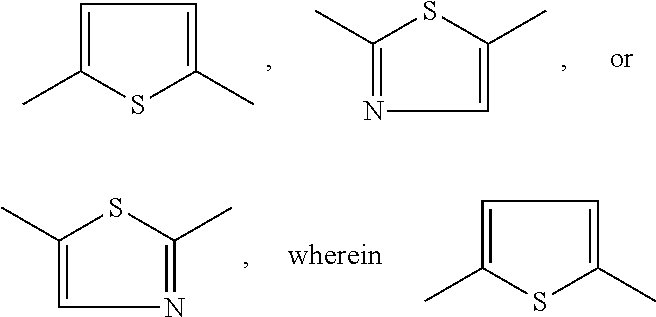

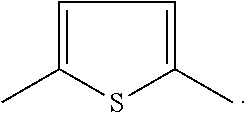
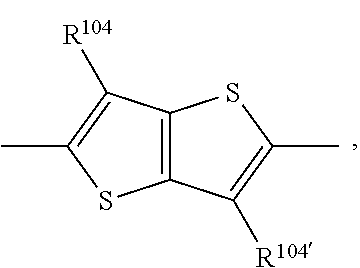


View All Diagrams
| United States Patent Application | 20110315967 |
| Kind Code | A1 |
| Schmidhalter; Beat ; et al. | December 29, 2011 |
Organic field effect transistor with improved current on/off ratio and controllable threshold shift
Abstract
The present invention provides a semiconductor device, especially an organic field effect transistor, comprising a layer comprising a polymer comprising repeating units having a diketopyrrolopyrrole skeleton (DPP polymer) and an acceptor compound having an electron affinity in vacuum of 4.6 eV, or more. The doping of the DPP polymer with the acceptor compound leads to an organic field effect transistor with improved hole mobility, current on/off ratio and controllable threshold shift.
| Inventors: | Schmidhalter; Beat; (Bubendorf, CH) ; Chebotareva; Natalia; (Hagenthal le Bas, FR) ; Hayoz; Pascal; (Hofstetten, CH) |
| Assignee: | BASF SE Ludwigshafen DE |
| Family ID: | 45351672 |
| Appl. No.: | 13/166307 |
| Filed: | June 22, 2011 |
Related U.S. Patent Documents
| Application Number | Filing Date | Patent Number | ||
|---|---|---|---|---|
| 61358027 | Jun 24, 2010 | |||
| Current U.S. Class: | 257/40 ; 252/500; 257/E51.006 |
| Current CPC Class: | H01B 1/127 20130101; H01L 51/0053 20130101; H01L 51/0036 20130101; H01L 51/0043 20130101; H01L 51/0566 20130101 |
| Class at Publication: | 257/40 ; 252/500; 257/E51.006 |
| International Class: | H01L 51/05 20060101 H01L051/05; H01B 1/12 20060101 H01B001/12 |
Claims
1. A semiconductor device, comprising a layer comprising a polymer comprising repeating units having a diketopyrrolopyrrole skeleton (DPP polymer) and an acceptor compound having an electron affinity (in vacuum) of 4.6 eV, or more.
2. The semiconductor device according to claim 1, which is an organic field effect transistor.
3. The semiconductor device according to claim 2, wherein the organic field effect transistor comprises a gate electrode, a gate insulating layer, a semiconductor layer, a source electrode, and a drain electrode, the semiconductor layer represents the layer comprising the DPP polymer and the acceptor compound.
4. The organic electronic device according to claim 1, wherein the DPP polymer is selected from polymers of formula * A .sub.n* (Ia), copolymers of formula * A-D .sub.n* (Ib), copolymers of formula * A-D .sub.x B-D .sub.y* (Ic), copolymers of formula * A-D .sub.r B-D .sub.s A-E .sub.t B-E .sub.u* (Id), wherein x=0.995 to 0.005, y=0.005 to 0.995, and wherein x+y=1; r=0.985 to 0.005, s=0.005 to 0.985, t=0.005 to 0.985, u=0.005 to 0.985, and wherein r+s+t+u=1; n is 4 to 1000, A is a group of formula ##STR00035## wherein a' is 1, 2, or 3, a'' is 0, 1, 2, or 3; b is 0, 1, 2, or 3; b' is 0, 1, 2, or 3; c is 0, 1, 2, or 3; c' is 0, 1, 2, or 3; d is 0, 1, 2, or 3; d' is 0, 1, 2, or 3; with the proviso that b' is not 0, if a'' is 0; R.sup.1 and R.sup.2 may be the same or different and are selected from hydrogen, a C.sub.1-C.sub.100alkyl group, --COOR.sup.106'', a C.sub.1-C.sub.100alkyl group which is substituted by one or more halogen atoms, hydroxyl groups, nitro groups, --CN, or C.sub.6-C.sub.18aryl groups and/or interrupted by --O--, --COO--, --COO--, or --S--; a C.sub.7-C.sub.100arylalkyl group, a carbamoyl group, C.sub.5-C.sub.12cycloalkyl, which can be substituted one to three times with C.sub.1-C.sub.8alkyl and/or C.sub.1-C.sub.8alkoxy, a C.sub.6-C.sub.24aryl group, in particular phenyl or 1- or 2-naphthyl which can be substituted one to three times with C.sub.1-C.sub.8alkyl, C.sub.1-C.sub.25thioalkoxy, and/or C.sub.1-C.sub.25alkoxy, or pentafluorophenyl, R.sup.106'' is C.sub.1--O.sub.50alkyl; Ar.sup.1, Ar.sup.1', Ar.sup.2, Ar.sup.2', Ar.sup.3, Ar.sup.3', Ar.sup.4 and Ar.sup.4' are independently of each other heteroaromatic, or aromatic rings, which optionally can be condensed and/or substituted with ##STR00036## wherein one of X.sup.3 and X.sup.4 is N and the other is CR.sup.99, R.sup.99, R.sup.104, R.sup.104', R.sup.123 and R.sup.123' are independently of each other hydrogen, halogen, or a C.sub.1-C.sub.25alkyl group, which may optionally be interrupted by one or more oxygen or sulphur atoms, C.sub.7-C.sub.25arylalkyl, or a C.sub.1-C.sub.25alkoxy group, R.sup.105, R.sup.105', R.sup.106 and R.sup.106' are independently of each other hydrogen, halogen, C.sub.1-C.sub.25alkyl, which may optionally be interrupted by one or more oxygen or sulphur atoms; C.sub.7-C.sub.25arylalkyl, or C.sub.1-C.sub.18alkoxy, R.sup.107 is C.sub.7-C.sub.25arylalkyl, C.sub.6-C.sub.18aryl; C.sub.6-C.sub.18aryl which is substituted by C.sub.1-C.sub.18alkyl, C.sub.1-C.sub.18perfluoroalkyl, or C.sub.1-C.sub.18alkoxy; C.sub.1-C.sub.18alkyl; C.sub.1-C.sub.18alkyl which is inter-rupted by --O--, or --S--; or --COOR.sup.124; R.sup.124 is C.sub.1-C.sub.25alkyl group, which may optionally be interrupted by one or more oxygen or sulphur atoms, C.sub.7-C.sub.25arylalkyl, R.sup.108 and R.sup.109 are independently of each other H, C.sub.1-C.sub.25alkyl, C.sub.1-C.sub.25alkyl which is substituted by E' and/or interrupted by D', C.sub.7-C.sub.25arylalkyl, C.sub.6-C.sub.24aryl, C.sub.6-C.sub.24aryl which is substituted by G, C.sub.2-C.sub.20heteroaryl, C.sub.2-C.sub.20heteroaryl which is substituted by G, C.sub.2-C.sub.18alkenyl, C.sub.2-C.sub.18alkynyl, C.sub.1-C.sub.18alkoxy, C.sub.1-C.sub.18alkoxy which is substituted by E' and/or interrupted by D', or C.sub.7-C.sub.25aralkyl, or R.sup.108 and R.sup.109 together form a group of formula .dbd.CR.sup.110R.sup.111, wherein R.sup.110 and R.sup.111 are independently of each other H, C.sub.1-C.sub.18alkyl, C.sub.1-C.sub.18alkyl which is substituted by E' and/or interrupted by D', C.sub.6-C.sub.24aryl, C.sub.6-C.sub.24aryl which is substituted by G, or C.sub.2-C.sub.20heteroaryl, or C.sub.2-C.sub.20heteroaryl which is substituted by G, or R.sup.108 and R.sup.109 together form a five or six membered ring, which optionally can be substituted by C.sub.1-C.sub.18alkyl, C.sub.1-C.sub.18alkyl which is substituted by E' and/or interrupted by D', C.sub.6-C.sub.24aryl, C.sub.6-C.sub.24aryl which is substituted by G, C.sub.2-C.sub.20heteroaryl, C.sub.2-C.sub.20heteroaryl which is substituted by G, C.sub.2-C.sub.18alkenyl, C.sub.2-C.sub.18alkynyl, C.sub.1-C.sub.18alkoxy, C.sub.1-C.sub.18alkoxy which is substituted by E' and/or interrupted by D', or C.sub.7-C.sub.25aralkyl, D' is --CO--, --COO--, --S--, --O--, or --NR.sup.112--, E' is C.sub.1-C.sub.8thioalkoxy, C.sub.1-C.sub.18alkoxy, CN, --NR.sup.112R.sup.113, --CONR.sup.112R.sup.113, or halogen, G is E', or C.sub.1-C.sub.18alkyl, and R.sup.112 and R.sup.113 are independently of each other H; C.sub.6-C.sub.18aryl; C.sub.6-C.sub.18aryl which is substituted by C.sub.1-C.sub.18alkyl, or C.sub.1-C.sub.18alkoxy; C.sub.1-C.sub.18alkyl; or C.sub.1-C.sub.18alkyl which is interrupted by --O-- and B, D and E are independently of each other a group of formula * Ar.sup.4 .sub.k Ar.sup.5 .sub.l Ar.sup.6 .sub.r Ar.sup.7 .sub.z* , or formula X, with the proviso that in case B, D and E are a group of formula X, they are different from A, wherein k is 1, l is 0, or 1, r is 0, or 1, z is 0, or 1, and Ar.sup.4, Ar.sup.5, Ar.sup.6 and Ar.sup.7 are independently of each other a group of formula ##STR00037## wherein one of X.sup.5 and X.sup.6 is N and the other is CR.sup.14, R.sup.14, R.sup.14', R.sup.17 and R.sup.17' are independently of each other H, or a C.sub.1-C.sub.25alkyl group, which may optionally be interrupted by one or more oxygen atoms.
5. The organic electronic device according to claim 1, wherein the DPP polymer is selected from polymers of formula ##STR00038## ##STR00039## n is 4 to 1000, R.sup.1 and R.sup.2 are a C.sub.1-C.sub.36alkyl group, R.sup.3 is a C.sub.1-C.sub.18alkyl group, R.sup.15 is a C.sub.4-C.sub.18alkyl group, x=0.995 to 0.005, y=0.005 to 0.995, and wherein x+y=1.
6. The semiconductor device according to claim 1, wherein the acceptor compound is a compound selected from quinoid compounds, such as quinone or quinone derivatives, 1,3,2-dioxaborines, 1,3,2-dioxaborine derivatives, oxocarbon-, pseudooxocarbon- and radialene compounds, and imidazole derivatives.
7. The semiconductor device according to claim 1, wherein the acceptor compound is a compound of formula ##STR00040## wherein R.sup.201 and R.sup.202 independently of one another are C.sub.1-C.sub.12alkyl, C.sub.1-C.sub.12alkyl, which is interrupted by one, or more oxygen atoms, C.sub.3-C.sub.8cycloalkyl which is unsubstituted or substituted by C.sub.1-C.sub.4alkyl, unsubstituted C.sub.6-C.sub.12aryl, or C.sub.3-C.sub.7heteroaryl, or benzyl, or C.sub.6-C.sub.12aryl, or C.sub.3-C.sub.7heteroaryl, or benzyl which is substituted by F, Cl, Br, C.sub.1-C.sub.6alkyl, C.sub.1-C.sub.6alkoxy, or di(C.sub.1-C.sub.6alkylamino); or a compound of formula ##STR00041## wherein R.sup.203 and R.sup.204 independently of one another are H, Cl, or C.sub.1-C.sub.25alkoxy.
8. The semiconductor device according to claim 7, wherein the acceptor compound is selected from ##STR00042## ##STR00043## ##STR00044##
9. The semiconductor device according to 6, wherein the acceptor compound is a compound selected from 2-(6-dicyanomethylene-1,3,4,5,7,8-hexafluoro-6H-naphthalen-2-ylidene)-mal- ononitrile, ##STR00045## 2,3,5,6-tetrafluoro-7,7,8,8-tetracyanoquinodimethane (F.sub.4-TCNQ), ##STR00046## ##STR00047##
10. The semiconductor device according to claim 9, wherein the acceptor compound is 2,3,5,6-tetrafluoro-7,7,8,8-tetracyanoquinodimethane (F.sub.4-TCNQ).
11. The semiconductor device according to claim 10, wherein the DPP polymer is represented by formula ##STR00048## wherein n is 5 to 100 and R.sup.1 and R.sup.2 are a C.sub.1-C.sub.36alkyl group.
12. The semiconductor device according to claim 1, wherein the acceptor compound is contained in an amount of 0.1 to 8% by weight based on the amount of DPP polymer and acceptor compound.
13. An organic semiconducting layer, comprising a polymer comprising repeating units having a diketopyrrolopyrrole skeleton (DPP polymer) and an acceptor compound having an electron affinity of greater than 4.6 eV.
14. A method of using the organic semiconducting layer according to claim 13 in an organic semiconductor device.
15. An apparatus comprising the organic semiconductor device according to claim 1.
16. An apparatus comprising the organic semiconducting layer according to claim 13.
Description
CROSS REFERENCES
[0001] This application claims the benefit of U.S. Provisional Application No. 61/358,027, filed Jun. 24, 2010.
DESCRIPTION
[0002] The present invention provides a semiconductor device, especially an organic field effect transistor, comprising a layer comprising a polymer comprising repeating units having a diketopyrrolopyrrole skeleton (DPP polymer) and an acceptor compound having an electron affinity in vacuum of 4.6 eV, or more. The doping of the DPP polymer with the acceptor compound leads to an organic field effect transistor with improved hole mobility, current on/off ratio and controllable threshold shift.
[0003] The doping of silicon semiconductors has already been state of art for several decades. By this method, an increase in conductivity, initially quite low, is obtained by generation of charge carriers in the material as well as, depending upon the type of dopant used, a variation in the Fermi level of the semiconductor. However, several years ago it was also disclosed that organic semiconductors may likewise be strongly influenced with regard to their electrical conductivity by doping. Such organic semiconducting matrix materials may be made up either of compounds with good electron-donor properties or of compounds with good electron-acceptor properties. For doping electron-donor materials, strong electron acceptors such as tetracyanoquinonedimethane (TCNQ) or 2,3,5,6-tetrafluorotetracyano-1,4-benzoquinonedimethane (F.sub.4TCNQ) have become well known. M. Pfeiffer, A. Beyer, T. Fritz, K. Leo, Appl. Phys. Lett., 73 (22), 3202-3204 (1998) and J. Blochwitz, M. Pfeiffer, T. Fritz, K. Leo, Appl. Phys. Lett., 73 (6), 729-731 (1998). By electron transfer processes, these produce so-called holes in electron donor-like base materials (hole-transport materials), owing to the number and mobility of which the conductivity of the base material is relatively significantly varied. For example, N,N'-perarylated benzidines TPD or N,N',N'' perarylated starburst compounds, such as the substance TDATA, but also certain metal phthalocyanines, such as in particular zinc phthalocyanine ZnPc, are known as matrix materials with hole-transport properties.
[0004] EP1538684A1 (US2005121667) relates to a method which uses an organic mesomeric compound as an organic doping material for doping an organic semiconducting material to alter its electrical properties. The mesomeric compound is a quinone or a quinone derivative or a 1,3,2-dioxaborin or a 1,3,2-dioxaborin derivative and the mesomeric compound has lower volatility than the tetrafluorotrecyanoquinonedimethane under identical evaporation conditions. It is said that the dopants may be used for the production of organic light-emitting diodes (OLEDs), organic solar cells, organic diodes, or organic field-effect transistors.
[0005] Preferably, the matrix material consists partially or completely of a metal phthalocyanine complex, a porphyrin complex, an oligothiophene compound, an oligophenyl compound, an oligophenylenevinylene compound, an oligofluorene compound, a pentacene compound, a compound with a triarylamine unit and/or a spiro-bifluorene compound. WO 2009003455A1 discloses further quinoid compounds and the use thereof in semiconducting matrix materials, electronic and optoelectronic components.
[0006] US2008265216A1 relates to oxocarbon-, pseudooxocarbon- and radialene compounds as well as to their use as doping agent for doping an organic semiconductive matrix material, as blocker material, as charge injection layer, as electrode material as well as organic semiconductor, as well as electronic components and organic semiconductive materials using them.
[0007] WO2008138580A1 relates to imidazole derivatives and the use thereof as dopants for doping organic semiconductor matrix materials, organic semiconductor matrix materials, and electronic or optoelectronic components.
[0008] EP1681733 and US2010005192 discloses an organic thin film transistor compromising an acceptor layer interposed between source-drain contacts and the semiconductor layer. The method requires an additional layer, which is done over an evaporative step, which is not preferred.
[0009] E. Lim et al., J. Mater. Chem. 2007, 17,1416-1420 presents results on organic transistors using the p-type polymer semiconductor (F8T2) doped with an electron-acceptor, 2,5,6,-tetrafluore-7,7,8,8-tetracyanoquinodimethane (F.sub.4TCNQ). Using an optimal doping ratio of 8 wt % doped F8T2 film an increased hole mobility was found, whereas the on/off ratio is in the same order for the doped (8 wt %) and the undoped film.
[0010] WO200906068869 discloses chemically modified silver electrodes by using F.sub.4TCNQ as selfassembling monolayer. This presence of the SAMs significantly shifts the transfer characteristics, which results in a rigid shift of the threshold voltage in the positive range. This requires more complex circuitry and is therefore not preferred.
[0011] W. Takashima et al., Appl. Physics Letters 91(7), 071905 and US201000065833 disclose complementary FET circuits with p-type organic and n-type materials, whereas the unipolarization is done by insertion of an acceptor layer for the p-type conducting transistor in an inverter structure.
[0012] X. Cheng et al., Adv. Funct. Material 2009, 19, 2407-2415 reports the modifaction of gold and drain electrodes by self-assembled thiol based monolayers in combination with the ambipolar polyfluorene semiconductor (F8BT). A simultaneous enhancement of electron and hole injection is found, which does not provide any means for improving the hole/electron ratio to achieve a high on/off ratio.
[0013] L. Ma et al., Applied Physics Letters 92 (2008) 063310 reported that the introduction of F.sub.4TCNQ in very small quantities improved the performance of poly(3-hexylthiophene) (P3HT) thin film transistors. The field effect mobility of the devices was enhanced and the threshold voltages could be controlled by adjusting the F.sub.4TCNQ concentration. WO2010/063609 relates to an electronic device, which comprises a compound of the formula
##STR00001##
wherein R.sup.1 and R.sup.2 independently of one another are C.sub.1-C.sub.12alkyl, C.sub.1-C.sub.12alkyl, which is interrupted by one, or more oxygen atoms, C.sub.3-C.sub.8cycloalkyl which is unsubstituted or substituted by C.sub.1-C.sub.4alkyl, unsubstituted C.sub.6-C.sub.12aryl, or C.sub.3-C.sub.7heteroaryl, or benzyl, or C.sub.6-C.sub.12aryl, or C.sub.3-C.sub.7heteroaryl, or benzyl which is substituted by F, Cl, Br, C.sub.1-C.sub.6alkyl, C.sub.1-C.sub.6alkoxy or di(C.sub.1-C.sub.6alkylamino).
[0014] The compound of the formula I is a n-type organic material, which is an intrinsically good semiconducting material, resulting in a high device stability and reliability.
[0015] Diketopyrrolopyrrole based polymers are, for example, described in WO2010/049321 and EP2034537.
[0016] It is the object of the present invention to provide new and improved organic field effect transistors (OFETs) to fabricate high quality OFETs by the choice of an ambipolar semiconductor material, which is described, for example, in WO2010/049321.
[0017] Said object has been solved by a semiconductor device, especially an organic field effect transistor, comprising a layer comprising a polymer comprising repeating units having a diketopyrrolopyrrole skeleton (DPP polymer) and an acceptor compound having an electron affinity in vacuum of 4.6 eV, or more; especially 4.8 eV, or more; very especially 5.0 eV, or more, which enables control of the charge carrier density.
[0018] In general, the acceptor compound has an electron affinity in vacuum of 6.0 eV, or less, especially 5.5 eV, or less. Accordingly, the acceptor compound has an electron affinity in vacuum of from 4.6 to 6.0 eV, especially 4.8 to 5.5 eV, very especially 5.0 to 5.5 eV. In general "doping" means to add a foreign substance for controlling the property of a semiconductor (particularly, for controlling the conduction type of a semiconductor).
[0019] The doping of the DPP polymer with the acceptor compound leads to an organic field effect transistor with improved hole mobility, current on/off ratio (I.sub.onn/I.sub.off) and controllable threshold shift.
[0020] Doping of the DPP polymers with acceptor compounds can lead to hole mobilities of greater than about 5.times.10.sup.-2 cm.sup.2/Vs and I.sub.on/I.sub.off ratios of 10.sup.5 or higher.
[0021] In addition, the threshold voltage can be controlled by varying the doping concentration of the dopant material (acceptor compound). The threshold voltage can be extracted form the transfer characteristics according IEEE-1620 (Test Methods for the Characterization of Organic Transistors and Materials).
[0022] The doping concentration affects the on/off ratio and threshold voltage. The on/off ratio refers to the ratio of the source-drain current, when the transistor is on to the source-drain current, when the transistor is off. The gate voltage by which the source/drain current changes from on to off, i.e. the threshold value of the gate voltage, is an important parameter of the performance of the transistor.
[0023] In general, the acceptor compound is contained in an amount of 0.1 to 20% by weight, especially 0.5 to 8% by weight, very especially 0.5 to 5% by weight, based on the amount of DPP polymer and acceptor compound. For field-effect transistors the doping ratio up to 8 wt % is relevant; doping more than 8 wt % leads to conductive polymers, which may be of interest as hole-injection layer for large scale applications (organic light emitting devices (OLEDs), solar cells etc.).
[0024] Doping of the respective compound of formula I (DPP polymer; matrix material) with the dopants (acceptor compound) to be used according to the present invention may be produced by one or a combination of the following methods: a) sequential deposition of the matrix material and dopant with subsequent in-diffusion of the dopant by heat treatment; b) doping of a matrix material layer by a solution of dopant with subsequent evaporation of the solvent by heat treatment; and c) doping of a solution, or dispersion of the matrix material by a solution of dopant with subsequent evaporation of the solvent by heat treatment.
[0025] The "polymer comprising repeating units having a diketopyrrolopyrrole (DPP) skeleton" refers to a polymer having one or more DPP skeletons represented by the following formula
##STR00002##
in the repeating unit.
[0026] The term polymer comprises oligomers as well as polymers. The oligomers of this invention have a weight average molecular weight of <4,000 Daltons. The polymers of this invention preferably have a weight average molecular weight of 4,000 Daltons or greater, especially 4,000 to 2,000,000 Daltons, more preferably 10,000 to 1,000,000 and most preferably 10,000 to 100,000 Daltons. Molecular weights are determined according to high-temperature gel permeation chromatography (HT-GPC) using polystyrene standards.
[0027] In case of polymers of the formula
* A .sub.n* (Ia)
and
* A-D .sub.n* (Ib)
polymers are more preferred, wherein n is 4 (especially 10) to 1000, especially 4 (especially 10) to 200, very especially 5 (especially 20) to 100. Less preferred are oligomers of the formula Ia and Ib, wherein n is 2, or 3.
[0028] Examples of DPP polymers and their synthesis are, for example, described in U.S. Pat. No. 6,451,459B1, WO05/049695, WO2008/000664, WO2010/049321, WO2010/049323, WO2010/108873 (PCT/EP2010/053655), WO2010/115767 (PCT/EP2010/054152), WO2010/136353 (PCT/EP2010/056778), and WO2010/136352 (PCT/EP2010/056776); and can be selected from polymers of formula
* A .sub.n* (Ia),
copolymers of formula
* A-D .sub.n* (Ib),
copolymers of formula
* A-D .sub.x* B-D .sub.y* (Ic),
copolymers of formula
* A-D .sub.r* B-D .sub.s A-E .sub.t B-E .sub.u* (Id),
wherein x=0.995 to 0.005, y=0.005 to 0.995, especially x=0.2 to 0.8, y=0.8 to 0.2, and wherein x+y=1; r=0.985 to 0.005, s=0.005 to 0.985, t=0.005 to 0.985, u=0.005 to 0.985, and wherein r+s+t+u=1; n is 4 to 1000, especially 4 to 200, very especially 5 to 100, A is a group of formula
##STR00003##
wherein a' is 1, 2, or 3, a'' is 0, 1, 2, or 3; b is 0, 1, 2, or 3; b' is 0, 1, 2, or 3; c is 0, 1, 2, or 3; c' is 0, 1, 2, or 3; d is 0, 1, 2, or 3; d' is 0, 1, 2, or 3; with the proviso that b' is not 0, if a'' is 0; R.sup.1 and R.sup.2 may be the same or different and are selected from hydrogen, a C.sub.1-C.sub.100alkyl group, --COOR.sup.106'', a C.sub.1-C.sub.100alkyl group which is substituted by one or more halogen atoms, hydroxyl groups, nitro groups, --CN, or C.sub.6-C.sub.18aryl groups and/or interrupted by --O--, --C--, --COO--, or --S--; a C.sub.7-C.sub.100arylalkyl group, a carbamoyl group, C.sub.5-C.sub.12cycloalkyl, which can be substituted one to three times with C.sub.1-C.sub.8alkyl and/or C.sub.1-C.sub.8alkoxy, a C.sub.6-C.sub.24aryl group, in particular phenyl or 1- or 2-naphthyl which can be substituted one to three times with C.sub.1-C.sub.8alkyl, C.sub.1-C.sub.25thioalkoxy, and/or C.sub.1-C.sub.25alkoxy, or pentafluorophenyl, R.sup.106'' is C.sub.1-C.sub.50alkyl, especially C.sub.4-C.sub.25alkyl; Ar.sup.1, Ar.sup.1', Ar.sup.2, Ar.sup.2', Ar.sup.3, Ar.sup.3', Ar.sup.4 and Ar.sup.4' are independently of each other heteroaromatic, or aromatic rings, which optionally can be condensed and/or substituted, especially
##STR00004##
wherein one of X.sup.3 and X.sup.4 is N and the other is CR.sup.99, R.sup.99, R.sup.104, R.sup.104', R.sup.123 and R.sup.123' are independently of each other hydrogen, halogen, especially F, or a C.sub.1-C.sub.25alkyl group, especially a C.sub.4-C.sub.25alkyl, which may optionally be interrupted by one or more oxygen or sulphur atoms, C.sub.7-C.sub.25arylalkyl, or a C.sub.1-C.sub.25alkoxy group, R.sup.105, R.sup.105', R.sup.106 and R.sup.106' are independently of each other hydrogen, halogen, C.sub.1-C.sub.25alkyl, which may optionally be interrupted by one or more oxygen or sulphur atoms; C.sub.7-C.sub.25arylalkyl, or C.sub.1-C.sub.18alkoxy, R.sup.107 is C.sub.7-C.sub.25arylalkyl, C.sub.6-C.sub.18aryl; C.sub.6-C.sub.18aryl which is substituted by C.sub.1-C.sub.18alkyl, C.sub.1-C.sub.18perfluoroalkyl, or C.sub.1-C.sub.18alkoxy; C.sub.1-C.sub.18alkyl; C.sub.1-C.sub.18alkyl which is interrupted by --O--, or --S--; or --COOR.sup.124; R.sup.124 is C.sub.1-C.sub.25alkyl group, especially a C.sub.4-C.sub.25alkyl, which may optionally be interrupted by one or more oxygen or sulphur atoms, C.sub.7-C.sub.25arylalkyl, R.sup.108 and R.sup.109 are independently of each other H, C.sub.1-C.sub.25alkyl, C.sub.1-C.sub.25alkyl which is substituted by E' and/or interrupted by D', C.sub.7-C.sub.25arylalkyl, C.sub.6-C.sub.24aryl, C.sub.6-C.sub.24aryl which is substituted by G, C.sub.2-C.sub.20heteroaryl, C.sub.2-C.sub.20heteroaryl which is substituted by G, C.sub.2-C.sub.18alkenyl, C.sub.2-C.sub.18alkynyl, C.sub.1-C.sub.18alkoxy, C.sub.1-C.sub.18alkoxy which is substituted by E' and/or interrupted by D', or C.sub.7-C.sub.25aralkyl, or R.sup.108 and R.sup.109 together form a group of formula .dbd.CR.sup.110R.sup.111, wherein R.sup.110 and R.sup.111 are independently of each other H, C.sub.1-C.sub.18alkyl, C.sub.1-C.sub.18alkyl which is substituted by E' and/or interrupted by D', C.sub.6-C.sub.24aryl, C.sub.6-C.sub.24aryl which is substituted by G, or C.sub.2-C.sub.20heteroaryl, or C.sub.2-C.sub.20heteroaryl which is substituted by G, or R.sup.108 and R.sup.109 together form a five or six membered ring, which optionally can be substituted by C.sub.1-C.sub.18alkyl, C.sub.1-C.sub.18alkyl which is substituted by E' and/or interrupted by D', C.sub.6' C.sub.24aryl, C.sub.6-C.sub.24aryl which is substituted by G, C.sub.2-C.sub.20heteroaryl, C.sub.2-C.sub.20heteroaryl which is substituted by G, C.sub.2-C.sub.18alkenyl, C.sub.2-C.sub.18alkynyl, C.sub.1-C.sub.18alkoxy, C.sub.1-C.sub.18alkoxy which is substituted by E' and/or interrupted by D', or C.sub.7-C.sub.25aralkyl,
D' is --CO--, --COO--, --S--, --O--, or --NR.sup.112--,
[0029] E' is C.sub.105thioalkoxy, C.sub.1-C.sub.8alkoxy, CN, --NR.sup.112R.sup.113, --CONR.sup.112R.sup.113, or halogen, G is E', or C.sub.1-C.sub.18alkyl, and R.sup.112 and R.sup.113 are independently of each other H; C.sub.6-C.sub.18aryl; C.sub.6-C.sub.18aryl which is substituted by C.sub.1-C.sub.18alkyl, or C.sub.1-C.sub.18alkoxy; C.sub.1-C.sub.18alkyl; or C.sub.1-C.sub.18alkyl which is interrupted by --O-- and B, D and E are independently of each other a group of formula
* Ar.sup.4 .sub.k Ar.sup.5 .sub.l Ar.sup.6 .sub.r Ar.sup.7 .sub.z*
, or formula X, with the proviso that in case B, D and E are a group of formula X, they are different from A, wherein k is 1, l is 0, or 1, r is 0, or 1, z is 0, or 1, and Ar.sup.4, Ar.sup.5, Ar.sup.6 and Ar.sup.7 are independently of each other a group of formula
##STR00005##
wherein one of X.sup.5 and X.sup.6 is N and the other is CR.sup.14, R.sup.14, R.sup.14', R.sup.17 and R.sup.17' are independently of each other H, or a C.sub.1-C.sub.25alkyl group, especially a C.sub.6-C.sub.25alkyl, which may optionally be interrupted by one or more oxygen atoms.
[0030] Preferred polymers are described in WO2010/049321.
[0031] Ar.sup.1 and Ar.sup.1' are especially
##STR00006##
very especially
##STR00007##
is most preferred.
[0032] Ar.sup.2, Ar.sup.2', Ar.sup.3, Ar.sup.3', Ar.sup.4 and Ar.sup.4' are especially
##STR00008##
very especially
##STR00009##
[0033] Additional preferred polymers are described in WO2010/108873.
[0034] Ar.sup.1 and Ar.sup.1' are especially
##STR00010##
very especially
##STR00011##
[0035] Ar.sup.2, Ar.sup.2', Ar.sup.3, Ar.sup.3', Ar.sup.4 and Ar.sup.4' are especially
##STR00012##
very especially
##STR00013##
[0036] The group of formula
* Ar.sup.4 .sub.k Ar.sup.5 .sub.l Ar.sup.6 .sub.r Ar.sup.7 .sub.z*
is preferably
##STR00014##
more preferably
##STR00015##
most preferred
##STR00016##
[0037] R.sup.1 and R.sup.2 may be the same or different and are preferably selected from hydrogen, a C.sub.1-C.sub.100alkyl group, especially a C.sub.8-C.sub.36alkyl group.
[0038] A is preferably selected from
##STR00017##
[0039] The group of formula
* Ar.sup.4 .sub.k Ar.sup.5 .sub.l Ar.sup.6 .sub.r Ar.sup.7 .sub.z*
is preferably a group of formula
##STR00018##
[0040] Examples of preferred DPP polymers of formula Ia are shown below:
##STR00019##
[0041] Examples of preferred DPP polymers of formula Ib are shown below:
##STR00020##
[0042] R.sup.1 and R.sup.2 are a C.sub.1-C.sub.36alkyl group, especially a C.sub.8-C.sub.36alkyl group. n is 4 to 1000, especially 4 to 200, very especially 5 to 100.
[0043] Examples of preferred DPP polymers of formula Ic are shown below:
##STR00021##
[0044] R.sup.1 and R.sup.2 are a C.sub.1-C.sub.36alkyl group, especially a C.sub.8-C.sub.36alkyl group. R.sup.3 is a C.sub.1-C.sub.18alkyl group. R.sup.15 is a C.sub.4-C.sub.18alkyl group. x=0.995 to 0.005, y=0.005 to 0.995, especially x=0.4 to 0.9, y=0.6 to 0.1, and wherein x+y=1. Polymers of formula Ic-1 are more preferred than polymers of formula Ic-2. The polymers preferably have a weight average molecular weight of 4,000 Daltons or greater, especially 4,000 to 2,000,000 Daltons, more preferably 10,000 to 1,000,000 and most preferably 10,000 to 100,000 Daltons.
[0045] Polymers of formula Ib-1 are particularly preferred. Reference is, for example made to Example 1 of WO2010/049321:
##STR00022##
(Mw=39'500, Polydispersity=2.2 (measured by HT-GPC)).
[0046] The "acceptor compound" indicates a compound exhibiting electron accepting properties with respect to the above polymer compound and having an electron affinity of greater than 4.6 eV, especially greater than 4.8 eV, very especially greater than 5.0 eV.
[0047] Electron affinity (EA) is the energy released when the material accepts electrons from vacuum. Electron affinity is not directly related to the polarity of a material nor is there any correlation between electron affinity and dielectric constant.
[0048] According to the present invention, EA can be determined from cyclic voltammetry experiments for the organic semiconductor or from its measured ionization energy by subtracting the bandgap energy. The ionization energy (IE) of the material can be determined from standard ultraviolet photoemission spectroscopy (UPS) experiments. Alternatively, the EA of the organic semiconductor can be measured in a more direct way or by standard cyclic voltammetry. The condition for introducing charge transfer for supplying electrons form the donor polymer is that the highest occupied molecular orbital level of the donor (ionisation potential corresponds to Ip) is over the lowest unoccupied molecular level of the acceptor molecule (expressed as electron affinity corresponding to EA)
[0049] The acceptor compounds are, for example, selected from quinoid compounds, such as a quinone or quinone derivative, 1,3,2-dioxaborines, a 1,3,2-dioxaborine derivatives, oxocarbon-, pseudooxocarbon- and radialene compounds and imidazole derivatives.
[0050] Such compounds have, for example, been described in K. Walzer, B. Maennig, M. Pfeiffer, and K. Leo, Chem. Rev. 107 (2007) 1233-1271, EP1596445A1 (quinone or a quinone derivative or a 1,3,2-dioxaborin or a 1,3,2-dioxaborin derivative), WO2009/003455A1 (quinoid compounds), WO2008/138580 (imidazole derivatives), and US2008/0265216 (oxocarbon-, pseudooxocarbon- and radialene compounds).
[0051] In a preferred embodiment of the present invention, the acceptor compound is a compound of formula
##STR00023##
wherein R.sup.201 and R.sup.202 independently of one another are C.sub.1-C.sub.12alkyl, C.sub.1-C.sub.12alkyl, which is interrupted by one, or more oxygen atoms, C.sub.3-C.sub.8cycloalkyl which is unsubstituted or substituted by C.sub.1-C.sub.4alkyl, unsubstituted C.sub.6-C.sub.12aryl, or C.sub.3-C.sub.7heteroaryl, or benzyl, or C.sub.6-C.sub.12aryl, or C.sub.3-C.sub.7heteroaryl, or benzyl which is substituted by F, Cl, Br, C.sub.1-C.sub.6alkyl, C.sub.1-C.sub.6alkoxy, or di(C.sub.1-C.sub.6alkylamino); or a compound of formula
##STR00024##
wherein R.sup.203 and R.sup.204 independently of one another are H, Cl, or C.sub.1-C.sub.25alkoxy. Compounds of formula III are, for example, described in U.S. Pat. No. 5,281,730, U.S. Pat. No. 5,464,697 and WO2010/063609 (PCT/EP2009/065687). Compounds of formula IV are, for example, described in EP860820. Specific examples of compounds of formula III and IV are shown below:
##STR00025## ##STR00026## ##STR00027##
[0052] Further specific examples of the acceptor compound include 2-(6-dicyanomethylene-1,3,4,5,7,8-hexafluoro-6H-naphthalen-2-ylidene)-mal- ononitrile,
##STR00028##
2,3,5,6-tetrafluoro-7,7,8,8-tetracyanoquinodimethane (F.sub.4
##STR00029## ##STR00030##
[0053] One of the acceptor compounds can be used alone, or two or more of these compounds can be used in combination.
[0054] The at present most preferred acceptor compound is F.sub.4-TCNQ. Said derivative is particularly good at doping the DPP polymer, binding to source/drain electrodes, and providing a good solubility in common solvents.
[0055] In a particularly preferred embodiment of the present invention the acceptor compound is 2,3,5,6-tetrafluoro-7,7,8,8-tetracyanoquinodimethane (F.sub.4-TCNQ), and the DPP polymer is represented by formula
##STR00031##
wherein n is 5 to 100 and R.sup.1 and R.sup.2 are a C.sub.1-C.sub.36alkyl group, especially a C.sub.8-C.sub.36alkyl group.
[0056] F.sub.4-TCNQ is preferably used in an amount of 0.5 to 5% by weight, based on the amount of DPP polymer Ib-1 and acceptor compound.
[0057] Halogen is fluorine, chlorine, bromine and iodine, especially fluorine.
[0058] C.sub.1-C.sub.25alkyl (C.sub.1-C.sub.18alkyl) is typically linear or branched, where possible. Examples are methyl, ethyl, n-propyl, isopropyl, n-butyl, sec.-butyl, isobutyl, tert.-butyl, n-pentyl, 2-pentyl, 3-pentyl, 2,2-dimethylpropyl, 1,1,3,3-tetramethylpentyl, n-hexyl, 1-methylhexyl, 1,1,3,3,5,5-hexamethylhexyl, n-heptyl, isoheptyl, 1,1,3,3-tetramethylbutyl, 1-methylheptyl, 3-methylheptyl, n-octyl, 1,1,3,3-tetramethylbutyl and 2-ethylhexyl, n-nonyl, decyl, undecyl, dodecyl, tridecyl, tetradecyl, pentadecyl, hexadecyl, heptadecyl, octadecyl, eicosyl, heneicosyl, docosyl, tetracosyl or pentacosyl. C.sub.1-C.sub.8alkyl is typically methyl, ethyl, n-propyl, isopropyl, n-butyl, sec.-butyl, isobutyl, tert.-butyl, n-pentyl, 2-pentyl, 3-pentyl, 2,2-dimethyl-propyl, n-hexyl, n-heptyl, n-octyl, 1,1,3,3-tetramethylbutyl and 2-ethylhexyl. C.sub.1-C.sub.4alkyl is typically methyl, ethyl, n-propyl, isopropyl, n-butyl, sec.-butyl, isobutyl, tert.-butyl.
[0059] C.sub.1-C.sub.25alkoxy (C.sub.1-C.sub.18alkoxy) groups are straight-chain or branched alkoxy groups, e.g. methoxy, ethoxy, n-propoxy, isopropoxy, n-butoxy, sec-butoxy, tert-butoxy, amyloxy, isoamyloxy or tert-amyloxy, heptyloxy, octyloxy, isooctyloxy, nonyloxy, decyloxy, undecyloxy, dodecyloxy, tetradecyloxy, pentadecyloxy, hexadecyloxy, heptadecyloxy and octadecyloxy. Examples of C.sub.1-C.sub.8alkoxy are methoxy, ethoxy, n-propoxy, isopropoxy, n-butoxy, sec.-butoxy, isobutoxy, tert.-butoxy, n-pentoxy, 2-pentoxy, 3-pentoxy, 2,2-dimethylpropoxy, n-hexoxy, n-heptoxy, n-octoxy, 1,1,3,3-tetramethylbutoxy and 2-ethylhexoxy, preferably C.sub.1-C.sub.4alkoxy such as typically methoxy, ethoxy, n-propoxy, iso-propoxy, n-butoxy, sec.-butoxy, isobutoxy, tert.-butoxy. The term "alkylthio group" means the same groups as the alkoxy groups, except that the oxygen atom of the ether linkage is replaced by a sulfur atom.
[0060] C.sub.2-C.sub.25alkenyl (C.sub.2-C.sub.18alkenyl) groups are straight-chain or branched alkenyl groups, such as e.g. vinyl, allyl, methallyl, isopropenyl, 2-butenyl, 3-butenyl, isobutenyl, n-penta-2,4-dienyl, 3-methyl-but-2-enyl, n-oct-2-enyl, n-dodec-2-enyl, isododecenyl, n-dodec-2-enyl or n-octadec-4-enyl.
[0061] C.sub.2-24alkynyl (C.sub.2-18alkynyl) is straight-chain or branched and preferably C.sub.2-8alkynyl, which may be unsubstituted or substituted, such as, for example, ethynyl, 1-propyn-3-yl, 1-butyn-4-yl, 1-pentyn-5-yl, 2-methyl-3-butyn-2-yl, 1,4-pentadiyn-3-yl, 1,3-pentadiyn-5-yl, 1-hexyn-6-yl, cis-3-methyl-2-penten-4-yn-1-yl, trans-3-methyl-2-penten-4-yn-1-yl, 1,3-hexadiyn-5-yl, 1-octyn-8-yl, 1-nonyn-9-yl, 1-decyn-10-yl, or 1-tetracosyn-24-yl.
[0062] C.sub.5-C.sub.12cycloalkyl is typically cyclopentyl, cyclohexyl, cycloheptyl, cyclooctyl, cyclononyl, cyclodecyl, cycloundecyl, cyclododecyl, preferably cyclopentyl, cyclohexyl, cycloheptyl, or cyclooctyl, which may be unsubstituted or substituted. The cycloalkyl group, in particular a cyclohexyl group, can be condensed one or two times by phenyl which can be substituted one to three times with C.sub.1-C.sub.4-alkyl, halogen and cyano. Examples of such condensed cyclohexyl groups are:
##STR00032##
in particular
##STR00033##
wherein R.sup.151, R.sup.152, R.sup.153, R.sup.154, R.sup.155 and R.sup.156 are independently of each other C.sub.1-C.sub.8-alkyl, C.sub.1-C.sub.8-alkoxy, halogen and cyano, in particular hydrogen.
[0063] C.sub.6-C.sub.24aryl (C.sub.6-C.sub.24aryl) is typically phenyl, indenyl, azulenyl, naphthyl, biphenyl, as-indacenyl, s-indacenyl, acenaphthylenyl, fluorenyl, phenanthryl, fluoranthenyl, triphenlenyl, chrysenyl, naphthacen, picenyl, perylenyl, pentaphenyl, hexacenyl, pyrenyl, or anthracenyl, preferably phenyl, 1-naphthyl, 2-naphthyl, 4-biphenyl, 9-phenanthryl, 2- or 9-fluorenyl, 3- or 4-biphenyl, which may be unsubstituted or substituted. Examples of C.sub.6-C.sub.12aryl are phenyl, 1-naphthyl, 2-naphthyl, 3- or 4-biphenyl, 2- or 9-fluorenyl or 9-phenanthryl, which may be unsubstituted or substituted.
[0064] C.sub.7-C.sub.25aralkyl is typically benzyl, 2-benzyl-2-propyl, .beta.-phenyl-ethyl, .alpha.,.alpha.-dimethylbenzyl, .omega.-phenyl-butyl, .omega.,.omega.-dimethyl-.omega.-phenyl-butyl, w-phenyl-dodecyl, .omega.-phenyl-octadecyl, .omega.-phenyl-eicosyl or .omega.-phenyl-docosyl, preferably C.sub.7-C.sub.18aralkyl such as benzyl, 2-benzyl-2-propyl, .beta.-phenyl-ethyl, .alpha.,.alpha.-dimethylbenzyl, .omega.-phenyl-butyl, .omega.,.omega.-dimethyl-.omega.-phenyl-butyl, .omega.-phenyl-dodecyl or .omega.-phenyl-octadecyl, and particularly preferred C.sub.7-C.sub.12aralkyl such as benzyl, 2-benzyl-2-propyl, .beta.-phenyl-ethyl, .alpha.,.alpha.-dimethylbenzyl, .omega.-phenyl-butyl, or .omega.,.omega.-dimethyl-.omega.-phenyl-butyl, in which both the aliphatic hydrocarbon group and aromatic hydrocarbon group may be unsubstituted or substituted. Preferred examples are benzyl, 2-phenylethyl, 3-phenylpropyl, naphthylethyl, naphthylmethyl, and cumyl.
[0065] The term "carbamoyl group" is typically a C.sub.1-18carbamoyl radical, preferably C.sub.1-8carbamoyl radical, which may be unsubstituted or substituted, such as, for example, carbamoyl, methylcarbamoyl, ethylcarbamoyl, n-butylcarbamoyl, tert-butylcarbamoyl, dimethylcarbamoyloxy, morpholinocarbamoyl or pyrrolidinocarbamoyl.
[0066] Heteroaryl is typically C.sub.2-C.sub.26heteroaryl (C.sub.2-C.sub.20heteroaryl), i.e. a ring with five to seven ring atoms or a condensed ring system, wherein nitrogen, oxygen or sulfur are the possible hetero atoms, and is typically an unsaturated heterocyclic group with five to 30 atoms having at least six conjugated .pi.-electrons such as thienyl, benzo[b]thienyl, dibenzo[b,d]thienyl, thianthrenyl, furyl, furfuryl, 2H-pyranyl, benzofuranyl, isobenzofuranyl, dibenzofuranyl, phenoxythienyl, pyrrolyl, imidazolyl, pyrazolyl, pyridyl, bipyridyl, triazinyl, pyrimidinyl, pyrazinyl, pyridazinyl, indolizinyl, isoindolyl, indolyl, indazolyl, purinyl, quinolizinyl, chinolyl, isochinolyl, phthalazinyl, naphthyridinyl, chinoxalinyl, chinazolinyl, cinnolinyl, pteridinyl, carbazolyl, carbolinyl, benzotriazolyl, benzoxazolyl, phenanthridinyl, acridinyl, pyrimidinyl, phenanthrolinyl, phenazinyl, isothiazolyl, phenothiazinyl, isoxazolyl, furazanyl or phenoxazinyl, which can be unsubstituted or substituted.
[0067] Possible substituents of the above-mentioned groups are C.sub.1-C.sub.8alkyl, a hydroxyl group, a mercapto group, C.sub.1-C.sub.8alkoxy, C.sub.1-C.sub.8alkylthio, halogen, halo-C.sub.1-C.sub.8alkyl, a cyano group, a carbamoyl group, a nitro group or a silyl group, especially C.sub.1-C.sub.8alkyl, C.sub.1-C.sub.8alkoxy, C.sub.1-C.sub.8alkylthio, halogen, halo-C.sub.1-C.sub.8alkyl, or a cyano group.
[0068] As described above, the aforementioned groups may be substituted by E' and/or, if desired, interrupted by D'. Interruptions are of course possible only in the case of groups containing at least 2 carbon atoms connected to one another by single bonds; C.sub.6-C.sub.18aryl is not interrupted; interrupted arylalkyl or alkylaryl contains the unit D' in the alkyl moiety. C.sub.1-C.sub.18alkyl substituted by one or more E' and/or interrupted by one or more units D' is, for example, (CH.sub.2CH.sub.2O).sub.1-9--R.sup.x, where R.sup.x is H or C.sub.1-C.sub.10alkyl or C.sub.2-C.sub.10alkanoyl (e.g. CO--CH(C.sub.2H.sub.5)C.sub.4H.sub.9), CH.sub.2--CH(OR.sup.y')--CH.sub.2--O--R.sup.y, where R.sup.y is C.sub.1-C.sub.18alkyl, C.sub.5-C.sub.12cycloalkyl, phenyl, C.sub.7-C.sub.15-phenylalkyl, and R.sup.y' embraces the same definitions as R.sup.y or is H; C.sub.1-C.sub.8alkylene-COO--R.sup.z, e.g. CH.sub.2COOR.sup.z, CH(CH.sub.3)COOR.sup.z, C(CH.sub.3).sub.2COOR.sup.z, where R.sup.z is H, C.sub.1-C.sub.18alkyl, (CH.sub.2CH.sub.2O).sub.1-9--R.sup.x, and R.sup.x embraces the definitions indicated above; CH.sub.2CH.sub.2--O--CO--CH.dbd.CH.sub.2; CH.sub.2CH(OH)CH.sub.2--O--CO--C(CH.sub.3).dbd.CH.sub.2.
[0069] The semiconductor device according to the present invention is preferably an organic field effect transistor. The organic field effect transistor comprises a gate electrode, a gate insulating layer, a semiconductor layer, a source electrode, and a drain electrode, the semiconductor layer represents the layer comprising the DPP polymer and the acceptor compound.
[0070] The organic semi-conductive material (DPP polymer and the acceptor compound) is solution processable, i.e. it may be deposited by, for example, inkjet printing.
[0071] An OFET device according to the present invention preferably comprises: [0072] a source electrode, [0073] a drain electrode, [0074] a gate electrode, [0075] a semiconducting layer, [0076] one or more gate insulator layers, and [0077] optionally a substrate, wherein the semiconductor layer comprises the DPP polymer and the acceptor compound.
[0078] The gate, source and drain electrodes and the insulating and semiconducting layer in the OFET device may be arranged in any sequence, provided that the source and drain electrode are separated from the gate electrode by the insulating layer, the gate electrode and the semiconductor layer both contact the insulating layer, and the source electrode and the drain electrode both contact the semiconducting layer.
[0079] Preferably the OFET comprises an insulator having a first side and a second side, a gate electrode located on the first side of the insulator, a layer comprising the DPP polymer and the acceptor compound located on the second side of the insulator, and a drain electrode and a source electrode located on the polymer layer.
[0080] The OFET device can be a top gate device or a bottom gate device.
[0081] Suitable structures and manufacturing methods of an OFET device are known to the person skilled in the art and are described in the literature, for example in WO03/052841.
[0082] Typically the semiconducting layer of the present invention is at most 1 micron (=1 .mu.m) thick, although it may be thicker if required. For various electronic device applications, the thickness may also be less than about 1 micron thick. For example, for use in an OFET the layer thickness may typically be 100 nm or less. The exact thickness of the layer will depend, for example, upon the requirements of the electronic device in which the layer is used.
[0083] The insulator layer (dielectric layer) generally can be an inorganic material film or an organic polymer film. Illustrative examples of inorganic materials suitable as the gate dielectric layer include silicon oxide, silicon nitride, aluminum oxide, barium titanate, barium zirconium titanate and the like. Illustrative examples of organic polymers for the gate dielectric layer include polyesters, polycarbonates, poly(vinyl phenol), polyimides, polystyrene, poly(methacrylate)s, poly(acrylate)s, epoxy resin, photosensitive resists as described in WO07/113,107 and the like. In the exemplary embodiment, a thermally grown silicon oxide (SiO.sub.2) may be used as the dielectric layer.
[0084] The thickness of the dielectric layer is, for example from about 10 nanometers to about 2000 nanometers depending on the dielectric constant of the dielectric material used. A representative thickness of the dielectric layer is from about 100 nanometers to about 500 nanometers. The dielectric layer may have a conductivity that is for example less than about 10.sup.-12 S/cm.
[0085] The gate insulator layer may comprise, for example, a fluoropolymer, like e.g. the commercially available Cytop 809M.RTM., or Cytop 107M.RTM. (from Asahi Glass). Preferably the gate insulator layer is deposited, e.g. by spin-coating, doctor blading, wire bar coating, spray or dip coating or other known methods, from a formulation comprising an insulator material and one or more solvents with one or more fluoro atoms (fluoro-solvents), preferably a perfluorosolvent. A suitable perfluorosolvent is e.g. FC75.RTM. (available from Acros, catalogue number 12380). Other suitable fluoropolymers and fluorosolvents are known in prior art, like for example the perfluoropolymers Teflon AF.RTM. 1600 or 2400 (from DuPont), or Fluoropel.RTM. (from Cytonix) or the perfluorosolvent FC 43.RTM. (Acros, No. 12377).
[0086] In order to form the organic active layer using the DPP polymer and the acceptor compound, a composition for the organic active layer including chloroform or chlorobenzene may be used. Examples of the solvent used in the composition for the organic active layer may include chloroform, chlorobenzene, dichlorobenzene, trichlorobenzene, and toluene, or mixtures thereof.
[0087] Examples of the process of forming the organic active layer may include, but may not be limited to, screen printing, printing, spin coating, dipping or ink jetting.
[0088] As such, in the gate insulating layer (gate dielectric) included in the OFET any insulator having a high dielectric constant may be used as long as it is typically known in the art. Specific examples thereof may include, but may not be limited to, a ferroelectric insulator, including Ba.sub.0.33Sr.sub.0.66TiO.sub.3 (BST: Barium Strontium Titanate), Al.sub.2O.sub.3, Ta.sub.2O.sub.5, La.sub.2O.sub.5, Y.sub.2O.sub.5, or TiO.sub.2, an inorganic insulator, including PbZr.sub.0.33Ti.sub.0.66O.sub.3 (PZT), Bi.sub.4Ti.sub.3O.sub.12, BaMgF.sub.4, SrBi.sub.2(TaNb).sub.2O.sub.9, Ba(ZrTi)O.sub.3(BZT), BaTiO.sub.3, SrTiO.sub.3, Bi.sub.4Ti.sub.3O.sub.12, SiO.sub.2, SiN.sub.x, or AlON, or an organic insulator, including polyimide, benzocyclobutane (BCB), parylene, polyvinylalcohol, polyvinylphenol, polyvinylpyrrolidine (PVP), acrylates such as polymethylmethacrylate (PMMA) and benzocyclobutanes (BCBs). The insulating layer may be formed from a blend of materials or comprise a multi-layered structure. The dielectric material may be deposited by thermal evaporation, vacuum processing or lamination techniques as are known in the art. Alternatively, the dielectric material may be deposited from solution using, for example, spin coating or ink jet printing techniques and other solution deposition techniques.
[0089] If the dielectric material is deposited from solution onto the organic semiconductor, it should not result in dissolution of the organic semiconductor. Likewise, the dielectric material should not be dissolved if the organic semiconductor is deposited onto it from solution. Techniques to avoid such dissolution include: use of orthogonal solvents, that is use of a solvent for deposition of the uppermost layer that does not dissolve the underlying layer, and crosslinking of the underlying layer. The thickness of the insulating layer is preferably less than 2 micrometers, more preferably less than 500 nm.
[0090] In the gate electrode and the source/drain electrodes included in the OFET of the present invention, a typical metal may be used, specific examples thereof include, but are not limited to, platinum (Pt), palladium (Pd), gold (Au), silver (Ag), copper (Cu), aluminum (Al), nickel (Ni). Alloys and oxides, such as molybdenum trioxide and indium tin oxide (ITO), may also be used. Preferably, the material of at least one of the gate, source and drain electrodes is selected from the group Cu, Ag, Au or alloys thereof. The source and drain electrodes may be deposited by thermal evaporation and patterned using standard photolithography and lift off techniques as are known in the art.
[0091] The substrate may be rigid or flexible. Rigid substrates may be selected from glass or silicon and flexible substrates may comprise thin glass or plastics such as poly(ethylene terephthalate) (PET), polyethylenenaphthalate (PEN), polycarbonate, polycarbonate, polyvinylalcohol, polyacrylate, polyimide, polynorbornene, and polyethersulfone (PES).
[0092] Alternatively, conductive polymers may be deposited as the source and drain electrodes. An example of such a conductive polymers is poly(ethylene dioxythiophene) (PEDOT) although other conductive polymers are known in the art. Such conductive polymers may be deposited from solution using, for example, spin coating or ink jet printing techniques and other solution deposition techniques.
[0093] The source and drain electrodes are preferably formed from the same material for ease of manufacture. However, it will be appreciated that the source and drain electrodes may be formed of different materials for optimisation of charge injection and extraction respectively.
[0094] Typical thicknesses of source and drain electrodes are about, for example, from about 40 nanometers to about 1 micrometer with the more specific thickness being about 100 to about 400 nanometers.
[0095] The length of the channel defined between the source and drain electrodes may be up to 500 microns, but preferably the length is less than 200 microns, more preferably less than 100 microns, most preferably less than 20 microns.
[0096] Other layers may be included in the device architecture. For example, a self assembled monolayer (SAM) may be deposited on the gate, source or drain electrodes, substrate, insulating layer and organic semiconductor material to promote crystallity, reduce contact resistance, repair surface characteristics and promote adhesion where required. Exemplary materials for such a monolayer include chloro- or alkoxy-silanes with long alkyl chains, e.g. octadecyltrichlorosilane.
[0097] The method of fabricating an ambipolar organic thin film transistor may include forming a gate electrode, a gate insulating layer, an organic active layer, and source/drain electrodes on a substrate, wherein the organic active layer (semiconductor layer) includes the DPP polymer and the acceptor compound. The organic active layer may be formed into a thin film through screen printing, printing, spin coating, dipping or ink jetting. The insulating layer may be formed using material selected from the group consisting of a ferroelectric insulator, including Ba.sub.0.33Sr.sub.0.66TiO.sub.3 (BST: Barium Strontium Titanate), Al.sub.2O.sub.3, Ta.sub.2O.sub.5, La.sub.2O.sub.5, Y.sub.2O.sub.5, or TiO.sub.2, an inorganic insulator, including PbZr.sub.0.33Ti.sub.0.66O.sub.3(PZT), Bi.sub.4Ti.sub.3O.sub.12, BaMgF.sub.4, SrBi.sub.2(TaNb).sub.2O.sub.9, Ba(ZrTi)O.sub.3(BZT), BaTiO.sub.3, SrTiO.sub.3, Bi.sub.4Ti.sub.3O.sub.12, SiO.sub.2, SiN.sub.x, or AlON, or an organic insulator, including polyimide, benzocyclobutane (BCB), parylene, polyvinylalcohol, or polyvinylphenol. The substrate may be formed using material selected from the group consisting of glass, polyethylenenaphthalate (PEN), polyethyleneterephthalate (PET), polycarbonate, polyvinylalcohol, polyacrylate, polyimide, polynorbornene, and polyethersulfone (PES). The gate electrode and the source/drain electrodes may be formed using material selected from the group consisting of gold (Au), silver (Ag), copper (Cu), aluminum (Al), nickel (Ni), and indium tin oxide (ITO).
[0098] The method of manufacturing the organic thin film transistor may comprise: depositing a source and drain electrode; forming a semiconductive layer on the source and drain electrodes, the semiconductive layer of comprising the DPP polymer and the acceptor compound in a channel region between the source and drain electrode. The organic semi-conductive material is preferably deposited from solution. Preferred solution deposition techniques include spin coating and ink jet printing. Other solution deposition techniques include dip-coating, roll printing and screen printing.
[0099] A bottom-gate OFET device may be formed using the method illustrated below.
1. Gate deposition and patterning (e.g. patterning of an ITO-coated substrate). 2. Dielectric deposition and patterning (e.g. cross-linkable, photopatternable dielectrics). 3. Source-drain material deposition and patterning (e.g. silver, photolithography). 4. Source-drain surface treatment. The surface treatment groups could be applied by dipping the substrate into a solution of the self-assembled material, or applying by spin coating from a dilute solution. Excess (un-attached) material can be removed by washing. 5. Deposition of the organic semiconductive material (e.g. by ink jet printing).
[0100] This technique is also compatible with top-gate devices. In this case, the source-drain layer is deposited and patterned first. The surface treatment is then applied to the source-drain layer prior to organic semiconductive material, gate dielectric and gate deposition.
[0101] OFETs have a wide range of possible applications. One such application is to drive pixels in an optical device (apparatus), preferably an organic optical device. Examples of such optical devices include photoresponsive devices, in particular photodetectors, and light-emissive devices, in particular organic light emitting devices. High mobility OTFTs are particularly suited as backplanes for use with active matrix organic light emitting devices, e.g. for use in display applications.
[0102] The following examples are included for illustrative purposes only and do not limit the scope of the claims. Unless otherwise stated, all parts and percentages are by weight.
EXAMPLES
Application Example
[0103] Bottom-gate thin film transistor (TFT) structures with p-Si gate (10 .OMEGA.cm) are used for all experiments. A high-quality thermal SiO.sub.2 layer of 300 nm thickness serves as gate-insulator of C.sub.i=32.6 nF/cm.sup.2 capacitance per unit area. Source and drain electrodes are patterned by photolithography directly on the gate-oxide. Gold source drain electrodes defining channels of width W=10 mm and varying lengths L=2.5, 5, 10, 20 .mu.m are used. Prior to deposition of the organic semiconductor the SiO.sub.2 surface is treated at 60.degree. C. with a 0.1 m solution of octadecyltrichlorosilane (OTS) in toluene for 20 minutes. After rinsing with iso-propanol the substrates are dried. Small quantities of F.sub.4TCNQ (Aldrich Company) are dissolved in o-xylene (puriss.) and then mixed with the DPP-polymer of formula
##STR00034##
(obtained according to Example 1 of WO2010/049321) in the following weight ratios: 0/100, 0.5/99.5, 1/99, 3/97, 6/94, and 8/92 (dopant to polymer weight ratio) to generate 0.5% by weight (5 mg DPP polymer in 10 mg o-xylene) starting solution. To improve the solubility the solutions are heated up to 80.degree. C. The semiconductor thin film is prepared by spin-coating of the doped solution. Before use the solution is filtered through a 0.2 .mu.m filter. The spin coating is accomplished at a spinning speed of 3000 rpm for about 20 seconds in ambient conditions to fabricate thin films (30-50 nm). The devices are dried at 150.degree. C. for 15 minutes before evaluation.
Transistor Performance
[0104] The transistor behaviour is measured on an automated (transistor prober TP-10, CSEM) using an Agilent 4155 C semiconductor parameter analyzer. The transfer characteristic is measured on devices with various channel length prepared in the same run. The field-effect mobilities are calculated in the saturation regime at V.sub.d=-30V. From these characteristics, the threshold voltage (V.sub.t) is extracted form the peak of the second derivative of the gate voltage dependent drain current as described in IEEE-1620. According to the transfer line method the contact resistance is computed at a source-drain voltage of 1V. The on/off currents are obtained at V.sub.gs=-30V and V.sub.ds=-30V, V.sub.gs=10V and V.sub.ds=-30 V, respectively.
[0105] Table 1 below shows the device characteristics of the DPP-based polymer doped with various F.sub.4-TCNQ amounts.
TABLE-US-00001 TABLE 1 Device F.sub.4-TCNQ.sup.1) .mu..sup.avg (cm.sup.2/Vs) I.sub.on/ I.sub.off V.sub.t (V) Comp. 0.0 0.096 2.5 .times. 10.sup.3 -9.0 Appl. Ex. 1 Appl. Ex. 1 0.5 0.053 2.6 .times. 10.sup.5 -4.0 Appl. Ex. 2 1.0 0.069 7.3 .times. 10.sup.5 0.6 Appl. Ex. 3 3.0 0.082 3.4 .times. 10.sup.5 4.8 Appl. Ex. 4 6.0 0.063 3.4 .times. 10.sup.4 12.1 Appl. Ex. 5 8.0 0.043 3.9 .times. 10.sup.1 17.6 .sup.1)amount of F.sub.4-TCNQ in % by weight based on the amount of F.sub.4-TCNQ and DPP polymer.
* * * * *














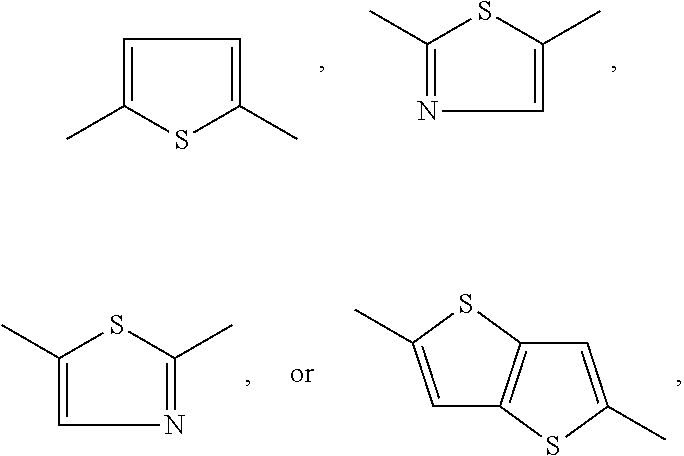

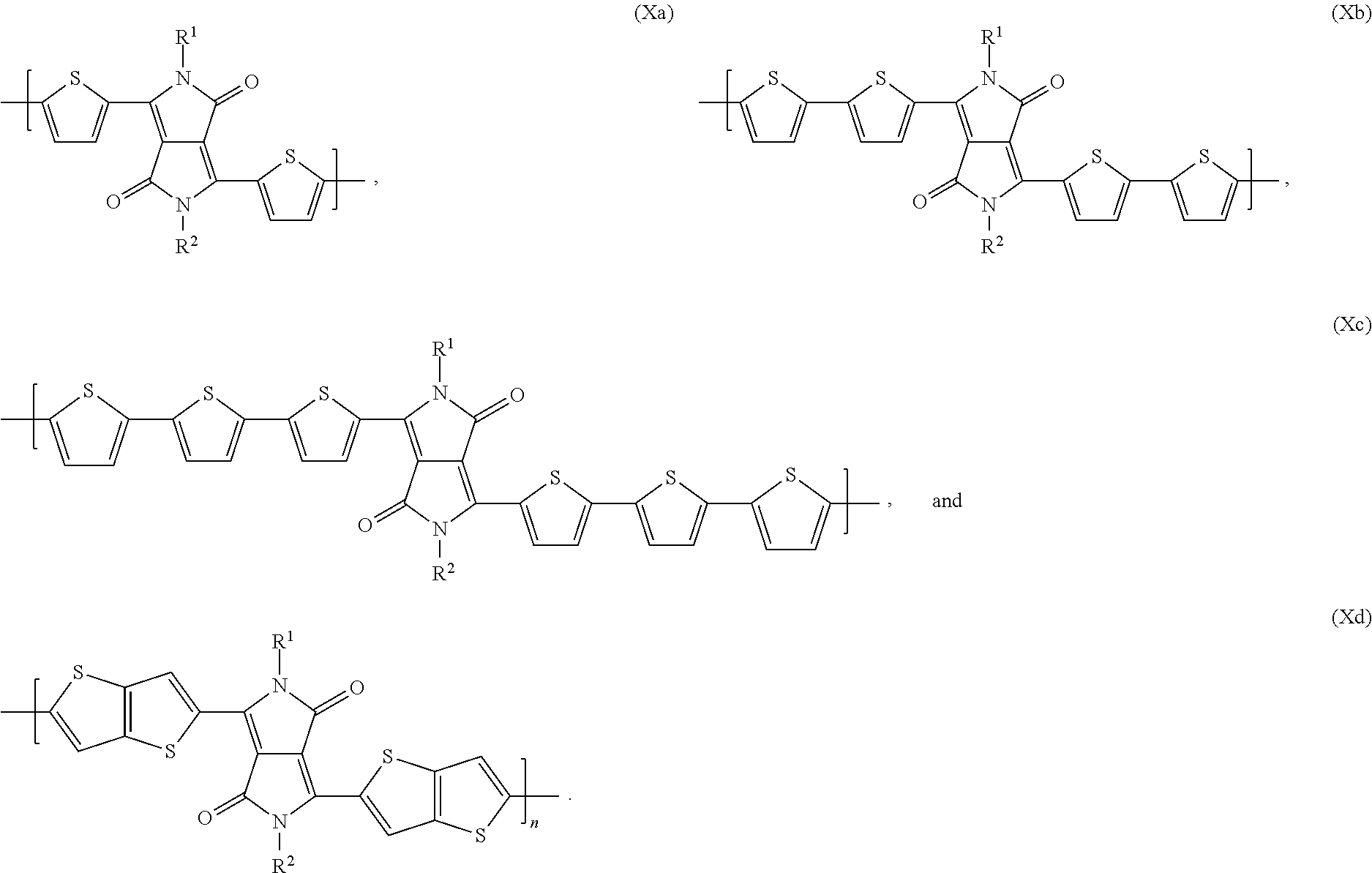

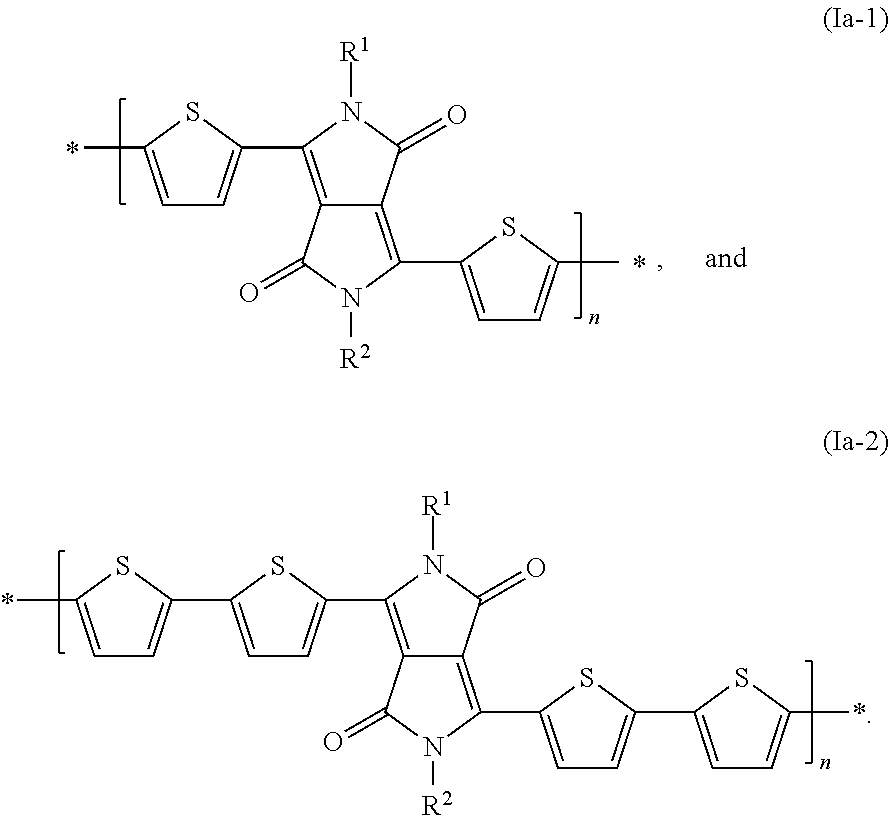


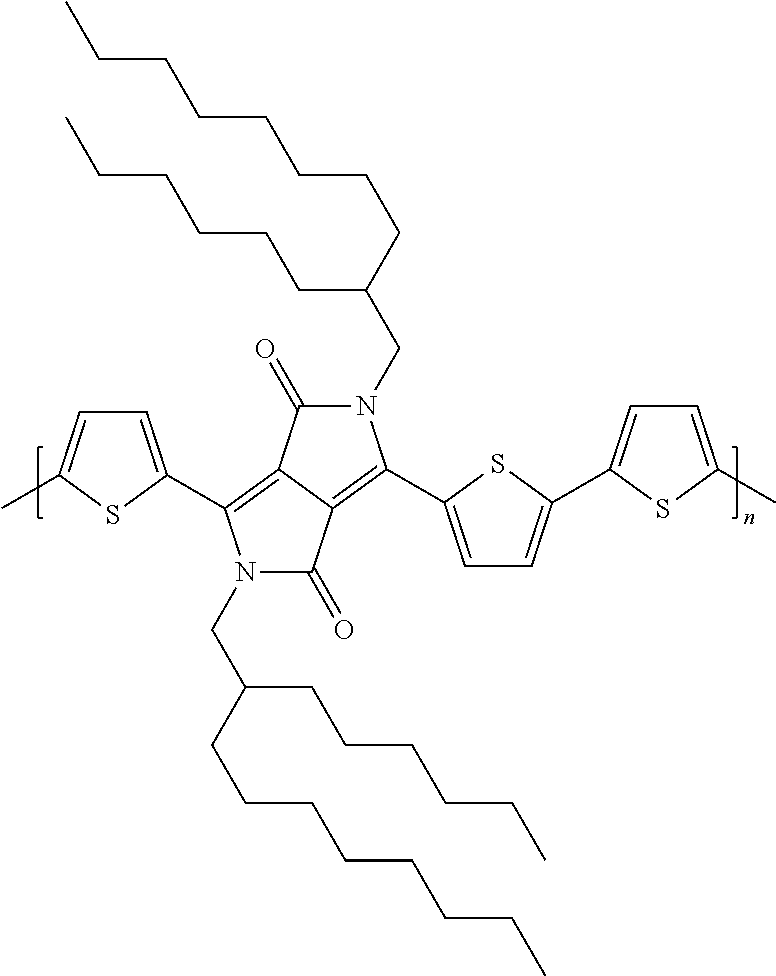

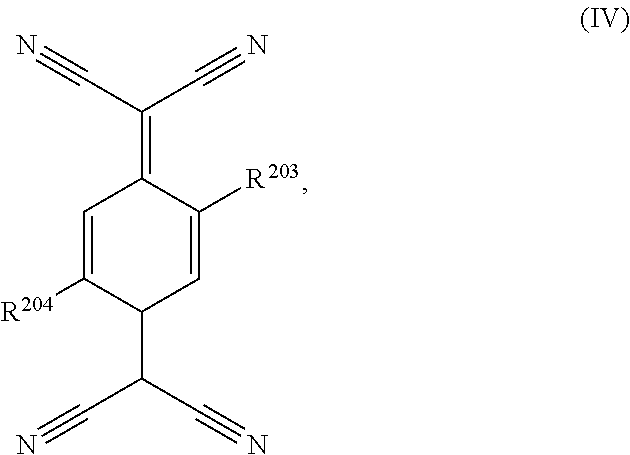









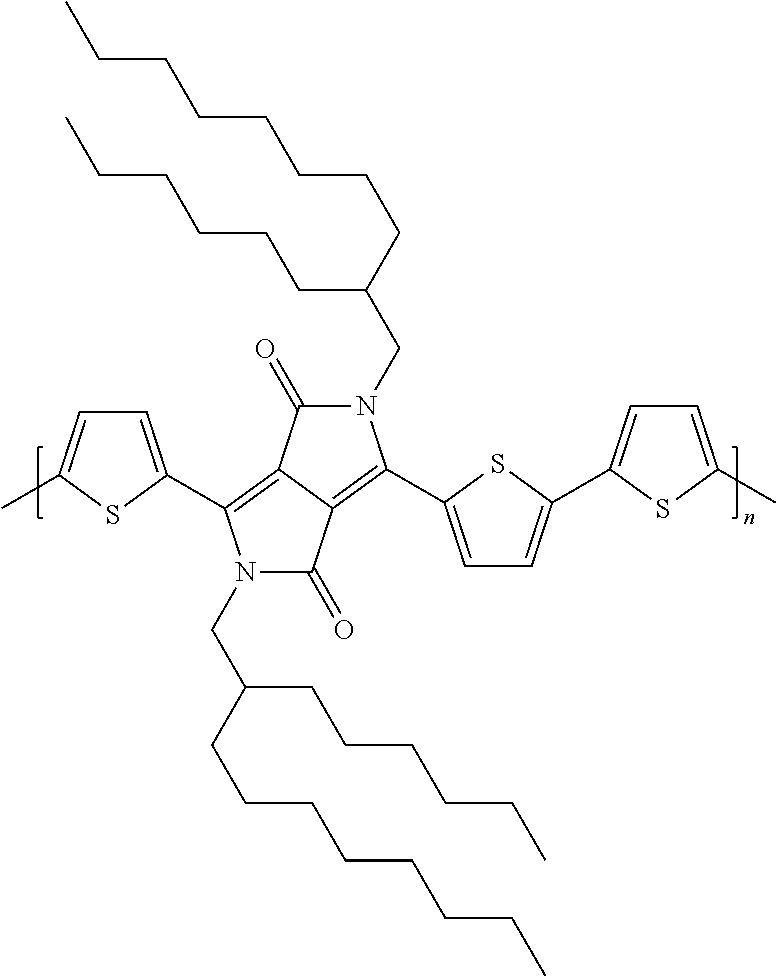














XML
uspto.report is an independent third-party trademark research tool that is not affiliated, endorsed, or sponsored by the United States Patent and Trademark Office (USPTO) or any other governmental organization. The information provided by uspto.report is based on publicly available data at the time of writing and is intended for informational purposes only.
While we strive to provide accurate and up-to-date information, we do not guarantee the accuracy, completeness, reliability, or suitability of the information displayed on this site. The use of this site is at your own risk. Any reliance you place on such information is therefore strictly at your own risk.
All official trademark data, including owner information, should be verified by visiting the official USPTO website at www.uspto.gov. This site is not intended to replace professional legal advice and should not be used as a substitute for consulting with a legal professional who is knowledgeable about trademark law.